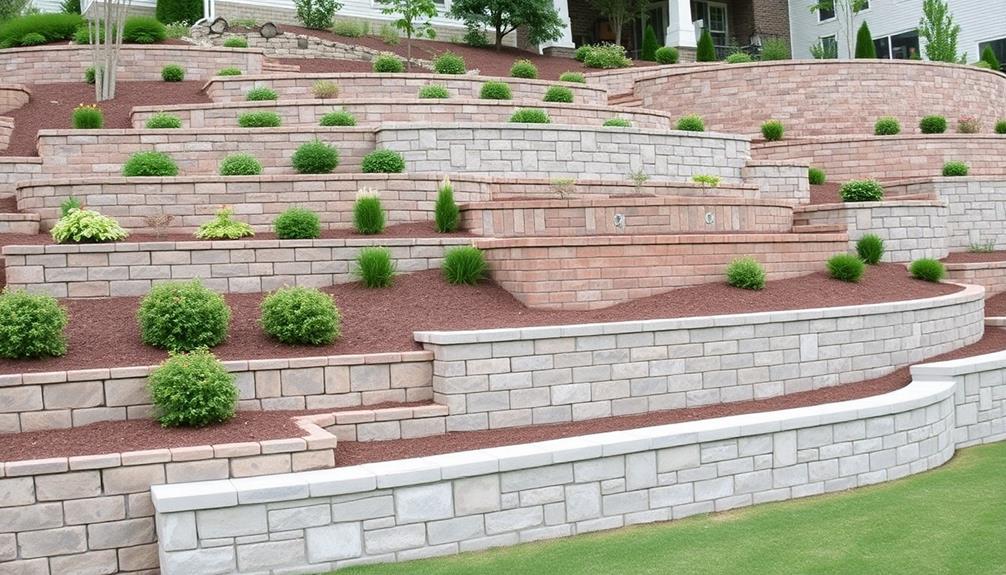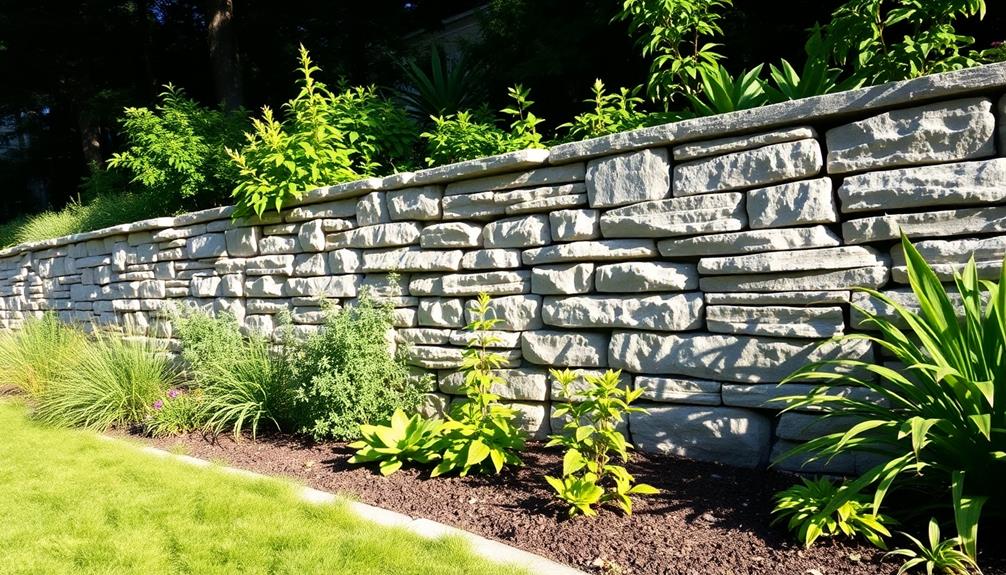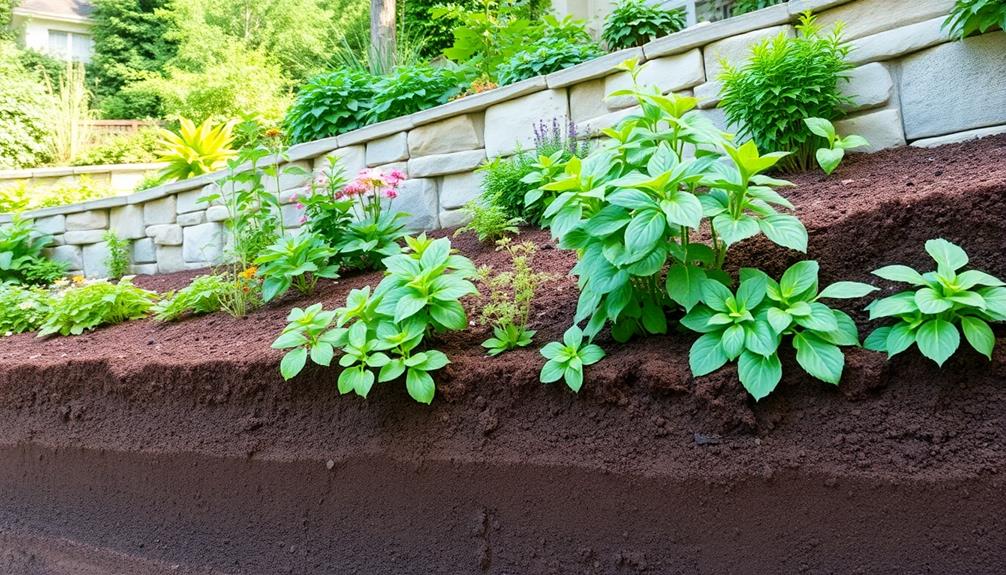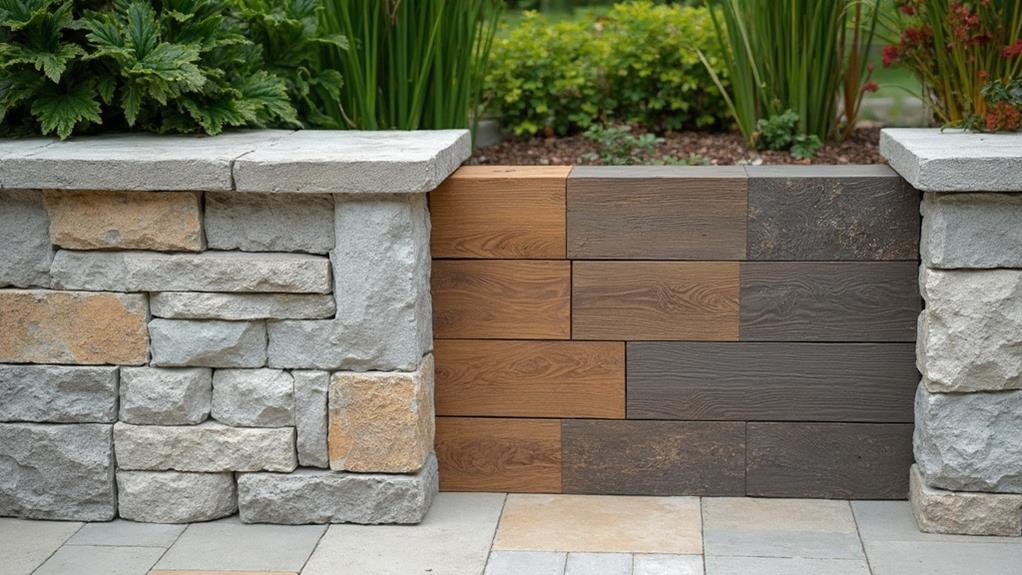Selecting the appropriate retaining wall materials requires an understanding of the wall's functionality and purpose, which includes stabilizing soil, managing water drainage, and promoting aesthetic harmony. Materials like timber offer an organic appearance but may require more maintenance, whereas concrete blocks provide durability and cost-effectiveness. For a more elegant touch, natural stone can be be used, while engineered systems confirm structural effectiveness. Evaluating soil conditions, such as cohesion and moisture levels, along with external load requirements, is essential for design integrity. Considering environmental impact is also important, as choosing sustainable materials contributes to long-term ecological responsibility. Exploring these elements further reveals strategic insights for ideal material selection.
Table of Contents
ToggleWalls Contractor Highlights
- Assess the soil type and condition to determine material requirements for structural stability.
- Consider environmental factors and choose eco-friendly materials like recycled concrete or locally sourced stone.
- Evaluate your budget and explore cost-effective options like pressure-treated timber or concrete blocks.
- Factor in aesthetic preferences to coordinate materials with landscape design for visual harmony.
- Account for external loads and select materials with sufficient strength to withstand local conditions.
Definition of Retaining Walls

Retaining walls serve a vital role in landscape architecture by stabilizing soil where elevation changes occur, effectively preventing erosion and managing water drainage. They not only enhance the usability of the space but can also serve as a decorative extension of the home.
Additionally, retaining walls can direct rainwater away from home, addressing potential water damage concerns. Their design must address specific structural needs to withstand lateral pressure, which varies depending on the materials used, such as concrete, stone, or timber.
The choice of materials impacts not only the wall's strength and longevity but also its aesthetic coherence with the surrounding environment, highlighting the significance of material selection in meeting both functional and design objectives.
Purpose and Functionality
A fundamental element of landscape architecture, retaining walls serve the essential purpose of holding back soil and preventing erosion in areas with varying elevations. These structures form critical components in the stabilization of slopes, transforming challenging topographies into safe and usable spaces. Beyond the technical intervention, they create a sense of order and harmony, blending functionality with aesthetic appeal.
The purpose of a retaining wall extends into its capacity to expand usable land in residential and commercial areas, facilitating gardens, terraces, and pathways that foster community interaction and enjoyment of the outdoors.
Retaining walls also mitigate the impact of stormwater runoff. By managing water flow and protecting against landslides, these structures are tailored to enhance the land's capacity to endure natural forces, integrating seamlessly into the landscape. Additionally, they encourage ecological preservation by preventing the loss of native vegetation, thereby enabling homeowners and developers to sustain environmental integrity.
These walls, varying in material and design, are pivotal in shaping not just the landscape but also the lives of those who inhabit it. When thoughtfully integrated into their surroundings, retaining walls help create cohesive environments, promoting a sense of belonging and shared stewardship of the natural world.
Design and Structural Needs
Many envision retaining walls as mere structural barriers, yet they embody a sophisticated blend of design and engineering tailored to specific contextual needs. At their essence, retaining walls serve the critical function of resisting lateral pressure from soil or other materials, safeguarding the integrity of landscapes and built environments.
The design of a retaining wall must consider the topography, soil characteristics, and intended use of the space to guarantee stability and durability, necessitating a seamless integration of form and function.
Aesthetically, retaining walls are capable of transforming a landscape, enhancing its visual appeal while also adding to its structural value. The choice of design is deeply intertwined with the environmental and architectural context, requiring a nuanced understanding of the surroundings.
Engineering aspects address concerns such as load-bearing capacity, drainage, and environmental conditions, emphasizing a strong, enduring foundation.
Together, these elements highlight the dual role retaining walls play: blending aesthetic enhancement with practical functionality. This multi-faceted nature invites designers and engineers alike to collaborate, ensuring that each wall is not only a reflection of technical precision but also a harmonious addition to the surrounding community.
Types and Materials Used
Understanding the importance of both design and structural needs in retaining walls naturally leads to an exploration of the various types and materials available for their construction. Equally essential for functionality and aesthetics, these walls play a vital role in landscape architecture by maintaining soil integrity and enhancing outdoor environments. Choosing the right type and material is fundamental, as it guarantees durability, cost-effectiveness, and seamless integration with existing landscapes.
Retaining walls can be made from an array of materials, each offering unique benefits suited to specific project requirements. Timber walls are favored for their organic appearance, providing a rustic charm that blends effortlessly with natural settings. While cost-effective, their lifespan can be limited by susceptibility to rot unless treated properly. Concrete blocks, by contrast, offer robust, long-lasting solutions and can be designed to simulate stone textures, providing both strength and versatility. Natural stone walls, though typically more expensive, offer unparalleled beauty and add timeless elegance to any landscape design. Engineered systems, such as segmental retaining walls, allow for structural effectiveness while accommodating various design complexities. Ultimately, the selection of material should marry the practical demands of the project with the desired aesthetic outcome, aligning with community and ecological values.
Benefits

The selection of appropriate retaining wall materials presents a multitude of benefits, including cost-effective solutions that align with budgetary constraints while ensuring enhanced structural integrity essential for long-term performance.
Boulder walls offer sustainable options by using natural stones, which reduce ecological impact while still meeting functional requirements. In addition, the wide array of materials available allows for aesthetic versatility, enabling customization that harmonizes with varying landscape designs.
Additionally, environmental considerations can be prioritized, as certain materials offer sustainable options that reduce ecological impact while still meeting functional requirements.
Cost-Effective Solutions
How can one effectively balance quality with budget constraints when selecting retaining wall materials? Striking the perfect equilibrium between cost and performance is essential, especially for those who wish to be conscientious stewards of their properties. A well-chosen retaining wall not only enhances the visual appeal of a space but also plays a functional role over time. When exploring cost-effective options, it's important to weigh a variety of factors to guarantee a decision that resonates well with both your objectives and collective needs.
Concrete Blocks: Known for their durability, these blocks provide a straightforward and affordable solution that offers versatility in design while maintaining structural integrity.
Pressure-Treated Timber: A natural choice that brings warmth to any landscape, offering a lower-cost alternative without compromising appearance, though regular maintenance is key to longevity.
Recycled Materials: Embracing sustainability, these materials not only reduce environmental impact but can also be acquired at a fraction of the cost of new ones, promoting both economic and ecological wisdom.
Enhanced Structural Integrity
When selecting materials for a retaining wall, the wall's structural integrity profoundly impacts its longevity and performance. The inherent strength of chosen materials guarantees that a retaining wall can effectively resist the pressures exerted by soil and water, providing a reliable solution to land management needs. High-quality materials, such as reinforced concrete, gabion systems, or carefully selected natural stones, fortify the wall's capacity to withstand adverse environmental conditions, including fluctuating temperatures and natural wear from erosion.
Enhanced structural integrity is indispensable, especially for retaining walls serving central roles in landscape architecture, such as terracing steep slopes or protecting infrastructures like roads and buildings. By focusing on structural soundness, communities and property owners are assured of a wall's capability to maintain terrain stability, fostering a shared commitment to sustainable land use practices. This assurance provides peace of mind, reinforcing community bonds through shared trust in the built environment.
Furthermore, materials with enhanced structural integrity often require less maintenance and fewer repairs over time, consequently reducing long-term costs and disruptions. Opting for durable and resilient materials supports community efforts towards achieving enduring landscapes, reflecting a collective pursuit of stability and harmony in both design and utility.
Aesthetic Versatility
Why limit the design potential of a retaining wall to functionality alone when it can also serve as an aesthetic asset? Modern landscaping recognizes the value of merging utility with beauty, transforming retaining walls into key elements of outdoor architecture. The choice of materials plays a significant role in achieving this balance, offering homeowners and designers alike the malleability to customize and enhance any landscape.
Aesthetic versatility in retaining wall materials allows for:
- Diverse textural finishes: From the ruggedness of natural stone to the sleekness of smooth concrete or the warmth of timber, textures add depth and character.
- Vibrant or muted hues: Material colors range from vibrant and eye-catching to subtle, earth-toned, allowing coordination with the broader landscape palette.
- Customization potential: Modular blocks and stackable systems enable unique designs, effortlessly adapting to various styles and themes.
Selecting the right materials fosters a sense of belonging within a community by ensuring that the retaining walls complement their surroundings and contribute positively to the neighborhood's visual harmony. This attention to detail not only elevates the aesthetics of the individual property but also enhances the collective appeal of the entire community, reflecting a shared commitment to beauty and individuality.
Environmental Considerations
Environmental factors are a critical aspect when selecting retaining wall materials, offering several benefits that extend beyond mere functionality. Choosing eco-friendly materials for retaining walls not only contributes to a sustainable environment but also caters to the growing community of environmentally conscious individuals who seek to belong to a larger mission of ecological preservation. By opting for materials such as recycled concrete, locally sourced stone, or timber from sustainably managed forests, one can greatly reduce the carbon footprint associated with manufacturing and transportation processes.
Implementing green materials supports biodiversity, as these substances often provide habitats for local flora and fauna, thereby strengthening local ecosystems. Additionally, environmentally friendly materials often possess superior durability, resulting in fewer replacements and thus, a reduced environmental impact over time. This enduring quality also lends itself to long-term cost-effectiveness, benefiting both the natural world and the wallet of the consumer.
Another considerable advantage to examine is the aesthetic harmony that nature-aligned materials naturally bring to landscape projects, enhancing not only the visual appeal but also fostering a deeper connection with the natural surroundings. Embracing these materials reflects a commitment to sustainable living, cultivating a shared sense of responsibility and belonging in our communities.
Soil Stability Considerations

When selecting appropriate materials for a retaining wall, soil stability considerations are paramount, necessitating a thorough assessment of soil composition to safeguard the structure's integrity against shifting or erosion. Evaluating moisture levels is equally critical, as fluctuating water content can drastically impact soil strength and wall durability. Additionally, determining load requirements allows for the appropriate design of the wall structure to withstand external pressures from both soil and environmental factors, upholding long-term stability.
| Consideration | Importance | Action Required |
|---|---|---|
| Soil Composition | Affects structure integrity | Conduct soil analysis |
| Moisture Levels | Influences soil strength | Monitor and regulate water |
| Load Requirements | Determines wall design | Calculate external pressures |
| Environmental Factors | Impacts durability | Evaluate local conditions |
| Erosion Prevention | Ensures sustainability | Implement control measures |
Assess Soil Composition
Understanding the soil composition is pivotal when considering the construction of a retaining wall, as it directly affects soil stability and, consequently, the wall's integrity. A well-assessed soil will guarantee the longevity and structural soundness of the retaining wall, thereby minimizing potential repair costs and enhancing the safety of your project.
The soil's characteristics can dictate the materials chosen for the wall, as different soils exert varying pressures. In this way, an informed decision requires an understanding of soil texture, cohesiveness, and compaction abilities.
- Soil Texture: Determine whether the soil is sandy, silt, or clay, as each poses distinct challenges for a wall's functionality and longevity. Sand, for example, is more prone to shifting than clay.
- Cohesiveness: Cohesive soils like clay bind together well, offering natural solidity. However, they might expand when wet and contract when dry, requiring careful planning.
- Compaction Ability: Properly compacted soil offers a solid foundation and reduces settling over time, which can jeopardize any wall structure.
Evaluate Moisture Levels
Moisture levels play a critical role in determining the stability of soil, making them a key factor to evaluate when planning a retaining wall. Proper assessment of moisture is essential, as it directly impacts the structural integrity and longevity of retaining walls. Excessive moisture can lead to saturation, resulting in increased pressure on the wall and the potential for failure, while insufficient drainage may cause water accumulation, further destabilizing the soil. Consequently, a thorough understanding of the moisture patterns in your landscape fosters a cohesive design that aligns with the natural terrain.
Engaging with soil and drainage experts to analyze local moisture dynamics is fundamental for a successful project. They can identify areas of concern, such as high rainfall zones or groundwater levels, and suggest materials and construction techniques suitable for balancing these conditions. The selection might include permeable materials to facilitate drainage or opting for solutions like weep holes or French drains to mitigate water buildup.
Determine Load Requirements
Determining load requirements is a critical aspect of designing a retaining wall, as it involves evaluating the forces exerted by the soil it supports. Understanding these load requirements guarantees the stability and longevity of the wall, preventing structural failures that could undermine the safety of your landscape. Carefully considering load requirements will offer you peace of mind and help you create a solution that not only stands the test of time but also enhances the beauty and functionality of your space.
Key Considerations:
- Soil Type and Condition: Evaluate the characteristics of the soil, including its composition, weight, and moisture content, as these factors influence the lateral pressure exerted on the wall. Cohesive soils, like clay, generally exert different pressures compared to granular soils such as sandy loam.
- Slope and Terrain: Examine how the natural gradient of the land influences soil stability. Steeper slopes may require more robust wall designs to counteract the added gravitational forces.
- External Loads: Consider additional loads, such as those from vehicles, buildings, or water flow, which may impact the stability. These external forces need to be accounted for in your design to prevent potential shifts or collapses.
Walls Contractor FAQ
What Are the Cost Differences Between Various Retaining Wall Materials?
Cost differences among retaining wall materials are significant, with concrete being more expensive than timber or stone. However, stone's variability in price can suit diverse budgets, fostering inclusivity in material choice for all community members.
How Do I Maintain My Retaining Wall for Longevity?
To guarantee the longevity of your retaining wall, implement regular inspections for structural integrity, clear drainage systems to prevent water buildup, and address minor repairs promptly. This proactive approach fosters reliability and enduring community harmony through well-maintained shared spaces.
What Environmental Factors Should I Consider When Selecting Retaining Wall Materials?
Consider soil composition, climate conditions, and water drainage when selecting retaining wall materials. Aligning material choice with environmental factors fosters structural integrity and longevity, ensuring that your retaining wall remains a lasting and harmonious part of your outdoor environment.
Are There Aesthetic Options Available for Retaining Wall Designs?
Certainly, there are numerous aesthetic options for retaining wall designs, including natural stone, brick, and concrete. Each material offers unique visual appeal, enabling personalized integration with landscape themes, fostering a sense of belonging within the space.
Can I Install a Retaining Wall Myself, or Should I Hire a Professional?
The decision to install a retaining wall yourself or hire a professional hinges on your skill level and project complexity. For a superior outcome and assurance, professional expertise guarantees structural integrity and enhances community cohesion through shared craftsmanship.







